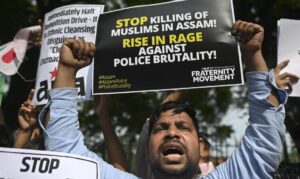Racial Conflicts and the Future of Assam
Racial Conflicts and the Future of Assam
Racial Conflicts and the Future of Assam
Assam is a Cauldron the bed of which has always been kept hot by the fire of communal, racial, tribal, regional and such other hundred-and-one problems and conflicts. The ultimate objective of which is to seize political autonomy. Of late the conflict which predominates in Assam is racial conflict the existence of which is visible since the days of independence. But in the 1980s the racial conflicts have taken a vigorous new shape. In 1993, with the formation of the Bodoland Autonomous Council, the racial conflicts among the various races of Assam became even more and more fierce and active. Now it stands as a menace to the unity in diversity of the state.
The word ‘Autonomy’ refers to a system of self-government which is given to a special geographical region or to a group of people related by common descent. To promote the socio-political condition as well as to keep up their traditional language and culture, the constitution of India has provided the scope of Autonomy to especially backward and underdeveloped areas, tribes, races and communities of India. In the 6th schedule of the Indian Constitution, this special privilege has been referred to and in accordance with this schedule, the Autonomous District Council had been formed in Assam after independence. By a special act, besides the 6th schedule, regional autonomies were rendered to the Bodos, Ravas, Micing and Tiwas. The main objective of it was to quicken the progress and development of the consisting races and tribes. But in reality, with the beginning of this system, a new and unwished racial conflict took birth in the concerning areas.
On the clue of the formation of the Bodoland Autonomous Council in 1993, the racial conflicts in Assam had revived with deadly violence and these conflicts affected the districts of Kukrajhar, Barpeta and Bongaigaon very pathetically and added new chapter of terror and unrest to the political history of Assam. Just after a few days of the formation of B.A.C. in Kukrajhar, a racial conflict broke out between the Bodos and the minority communities where 18,000 people of 3568 families lost their homes and houses and became refugees. About 2,02,684 people from 42,214 families became the victims of this conflicts. Again, in the same district, in 1998 the conflict revived and 314,342 people out of 48,556 families became refugees. A total of one-third of the population lost their homes as an effect of all these conflicts. Many died in these conflicts and many of them met their death in the refugee camps for want of food and proper hygiene. Thus many become the victims of such conflicts in the district of Barpeta and Bongaigaon also.
When B.A.C. was formed, then the ABSU and B.L.T. began another Gorilla struggle protesting against the formation of B.A.C. They alleged that B.A.C. was not enough to fulfill the hopes and wishes of them. In the aftermath of the movement the government made a truce with the B.L.T. and a proposal of forming B.T.C. under the 6th schedule of the Indian Constitution was taken. But since the day of taking such a proposal, the non-Bodos of lower Assam began to be united and showed their reaction. The government paid no attention to their reaction and amid much controversy they had been given autonomy under the 6th schedule of the constitution. In such a circumstance the Ravas, Micing, Tiwas, and others also began to cry aloud to have the same privilege. Consequently, the same terror and violence began to appear in the Micing, Rava and Tiwas areas as occurred in Kukrajhar.
Now our question is—why have they demanded autonomy? The answer to the question is transparent that though the consisting tribes or races are the aborigines of Assam, yet they have been being looked down upon by the government authorities since the independence of India. As a result, the Socio-political phenomena of these tribes remain the same as it was before the independence. In other words, to say, they have been deprived of all the effective schemes and planning for Socio-economic progress and development.
In giving political autonomy, we should have no objection because we see that Jharkhand as an autonomous state took birth out of Bihar and thus Uttaranchal was created dividing Uttar Pradesh and Chattishghar from Madhya Pradesh. The newly created autonomous states were economically underdeveloped while they had been the parts of the states from where they were cut off. But after their creation as separate states, they have been rising up economically. So if the autonomous states have been provided to the different races and tribes of Assam then their Socio-economic condition would rise up and it is because the respective tribes would be able to give special emphasis to the development of their condition.
But here again, a question arises concerning the number of such tribes, races and geographical territories. Because Assam is a state made up of an amalgamation of many castes, tribes, races and communities. In short, Assam is a union of diverse races and tribes. There are more than two hundred races, castes and communities. And if all the races and tribes (following the Bodos and few others, to which political autonomy have been given) demand autonomy for themselves then another difficult problem would come out concerning the geographical territories. It is because, in Assam, there is not an area of 10 kilometers where we can find only one community living there. As B.A.C. and B.T.C. is not the territory for the Bodos only—there are Ravas, Koches, Nepalis, Muslims etc. In such a way there are non-Bodos, and non-Micing in the autonomous council of the Ravas, Micing and Tiwas. If such a territory is brought under a particular tribe then the people of other tribes living there must get neglected. As against B.A.C. and B.T.C. all the non-Bodos have united and begun the anti-Bodo Movement. In this way against the autonomous in Karbi-Anglan all the non-Karbis have gathered and formed the United Tribal Revolutionary Front. In the Rava-Hasang area all the non-Rava and Hasang as—the Bodos, Garos and others have united against the Rava-Hasang and have been asking for the same status. Already in Lakhimpur, the non-Micing Fronts have begun to show their grievance against the autonomous status of the Micings. It seems that in the imminent future, the racial conflicts among all the tribes throughout Assam would rise up with more vigorously and the state must face another deadly disaster as was faced by Kukrajhar.
It is said that in giving autonomy to certain territories, there should have no objection. But in giving autonomous status to only a particular tribe or locality it must be ascertained that in doing so no other tribe or race loses its rights. The 1991 census shows that the percentage of the Bodos living in the district of Kukrajhar is 28.5%, Bongaigaon 12%, Nalbari 12.4%, Darrang 16.8%, Sonitpur 9.4% and North Kamrup 5.1%. In such a respect, it cannot be reasonable to insert lower Assam in Bodoland.
Here it is to allude as a reference that at the time of forming Bodoland, Dr. Bupindra Singh committee had suggested creating a Three-fold Satellite Autonomous Administration which gave emphasis on inserting the majority of Bodo villages in forming B.A.C. But his suggestion was not followed.
In conclusion, it is to say, that if autonomy is given to any race or tribe without a fixed geographical territory then it will create new and new problems every day. It is because all the tribes of Assam must demand autonomy for the respective groups of people which is impossible as there are many and many tribes, castes, and communities living in Assam. So, if it becomes necessary and urgent to give autonomy then this status should be given to certain geographical territories and such territories should be created not after the consideration of the demand of any tribe, but for the advantage of administration. Otherwise, Assam must lose its existence from the map of the world. 0 0 0.
Racial Conflicts and the Future of Assam
You May Like: Positive Thought, Patience and Perseverance
Racial Conflicts and the Future of Assam
N. B. The article ‘Racial Conflicts and the Future of Assam’ originally belongs to the book ‘Articles on Contemporary Affairs‘ by Menonim Menonimus.
Racial Conflicts and the Future of Assam
Books of Composition by M. Menonimus:
- Advertisement Writing
- Amplification Writing
- Note Making
- Paragraph Writing
- Notice Writing
- Passage Comprehension
- The Art of Poster Writing
- The Art of Letter Writing
- Report Writing
- Story Writing
- Substance Writing
- School Essays Part-I
- School Essays Part-II
- School English Grammar Part-I
- School English Grammar Part-II..
Books on Literary Criticism by M. Menonimus:
- World Short Story Criticism
- World Poetry Criticism
- World Drama Criticism
- World Novel Criticism
- World Essay Criticism
- Indian English Poetry Criticism
- Indian English Poets and Poetry Chief Features
- Emily Dickinson’s Poetry-A Thematic Study
- Walt Whitman’s Poetry-A Thematic Study
- Critical Essays on English Poetry
- Tawfiq al-Hakim’s Novel: Return of the Spirit-An Analytical Study
- Tawfiq al-Hakim’s Novel: ‘Yawmiyyat Naib Fil Arayaf’-An Analytical Study
- Analytical Studies of Some Arabic Short Stories
- A Brief History of Arabic Literature: Pre-Islamic Period (500 AD-622 AD)
- A Brief History of Arabic Literature: Early Islamic Period (622 AD-661 AD) …
Related Search:
- Recent Ethnic Conflict in Assam
- Ethnic Conflict in Assam











